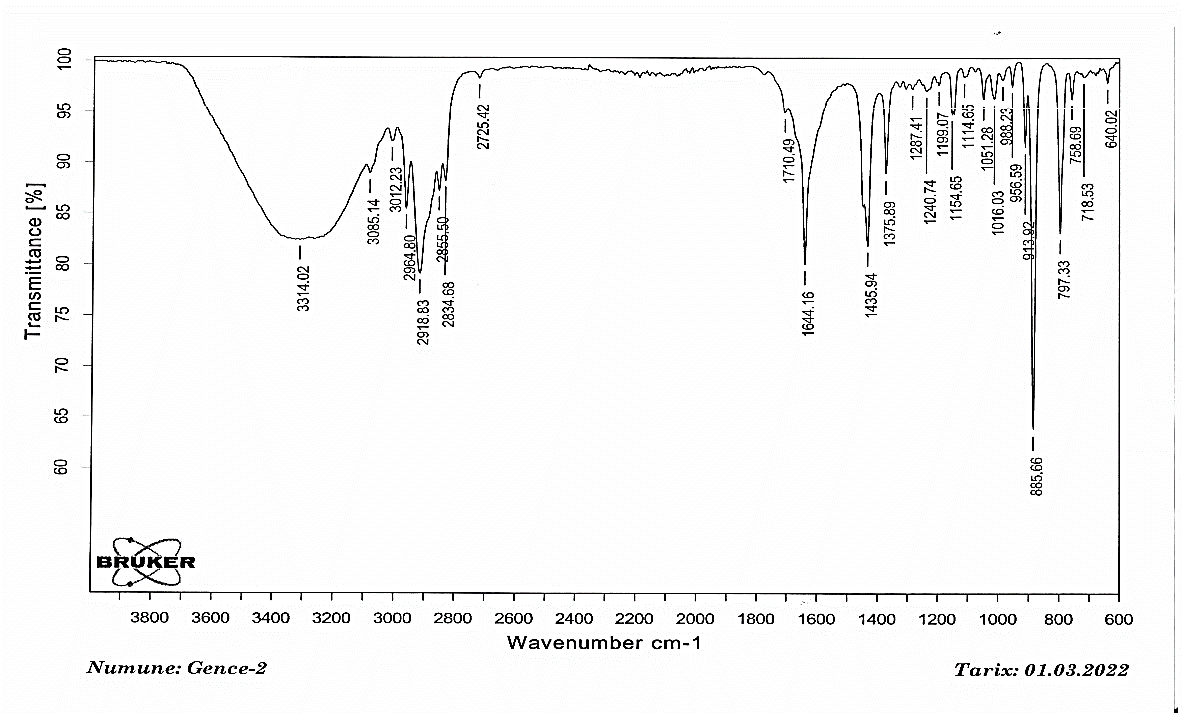STUDY OF THE ESSENTIAL OIL OBTAINED FROM JUNIPER PLANT BY PHYSICAL-CHEMICAL METHODS
UDC 547.913:543.2
Аннотация
Plants are natural resource with a perfect structure that can meet many needs of people and show diversity since hundreds of years. All over the world and in our country, plants have been used for a long time in the preparation of tea, spices, perfumes, ointments and medicines used in the treatment of diseases. Essential oils arelarge group of biologically active compounds contained in plants. In the article, the process of extracting essential oil from the juniper plant (Juniperus communis L.) at different yields was studied. Juniper fruit 200.47 g; 200.28 g; when 200.54 g, the average amount of essential oil according to wet raw material was determined to be 1.2±1.4%. The composition of the essential oil obtained from juniper fruit, rich in biologically active substances and important for treatment, was studied by physicochemical methods (chromatographic, Ultraviolet (UV) and Infrared (IR) spectroscopic). In the chromatogram of the essential oil, it was determined that there is a peak of monoterpenoids with a tricyclic structure. Absorption bands obtained as a result of spectral analysis ensure the correctness of the composition of the synthesized essential oil. On the basis of medicinal properties of the juniper plant (Juniperus communis L.), the obtained essential oil can be used in medicine and cosmetology in the preparation of ointments and lotions with various ingredients.
Скачивания
Metrics
Литература
Mohamadi M., Shamspur T., Mostafavi A. J. Essent. Oil Res., 2013, vol. 25, no. 1, pp. 55–61.
Boren K.E. et al. J. Environ. Anal. Chem., 2015, vol. 2, no.2, pp. 100–132.
JungJ. et al. Eur. Food Res. Technol., 2005, vol. 220, pp. 232–237.
Hoer K. et al. J. Agric. Food Chem., 2001, vol. 49, pp. 21–25.
Souza R. et al. Anal. Lett., 2011, vol. 44, pp. 2417–2422.
Feudjio W.M. et al. Food Anal. Methods, 2017, vol. 10, pp. 2539–2548.
Baser K.H.C., Buchbauer G. Handbook of Essential Oils: Science, Technology, and Applications. Boca Raton: Taylor & Francis, 2009, 1128 p.
Pellati F. et al. Rapid Comm. Mass Spectrom., 2013, vol. 27, pp. 591–602.
Selivanova N.V., Samsonova N.V., Qusakova M.A., Boqolichin K.Q., Boqdanova M.B. Lesn. Journal, 2019, no. 6, pp. 241–254. DOI: 10.37482/0536-1036-2019-6-241. (in Russ.).
GOST ISO 875-2014. Masla efirnyye. Metod opredeleniya rastvorimosti v etilovom spirte. [GOST ISO 875-2014. Es-sential oils. Method for determining solubility in ethyl alcohol]. Moscow, 2015, 11 p. (in Russ.).
Standarty po ISO/TC 54. Essential oils. [Standards for ISO/TC 54. Essential oils]. URL: https://www.iso.org/ru/committee/48956/x/catalogue/p/1/u/0/w/0/d/0. (in Russ.).
Sciarrone D. et al. J. Chromatogr. A., 2011, vol. 1218, pp. 137–142.
Russo M. et al. J. Essent. Oil Res., 2015, vol. 27, no. 4, pp. 307–315.
Waksmundzka-Hajnos M., Sherma J., Kowalska T. Thin Layer Chromatography in Phytochemistry. Chromatographic science series, Boca Raton: CRC Press, 2008, vol. 99, 896 p.
Tashmatov Z.O., Eshbakova K.A., Bobakulov Kh.M. Chem. Nat. Compd., 2011, vol. 47, pp. 440–441. DOI: 10.1007/s10600-011-9955-8.
Skaltsa H.D., Lazari D.M., Kyriazopoulos P., Golegou S., Triantaphyllidis S., Sokovic M., Kypriotakis Z.J. Essent. Oil Res., 2005, vol. 17, pp. 232–235. DOI: 10.1080/10412905.2005.9698886.
Karimov A.M., Ostroushko Yu.V., Botirov E.Kh. Chem. Nat. Compd., 2019, vol. 55, pp. 545–546. DOI: 10.1007/s10600-019-02737-0.
Cicek M., Demirci B., Yilmaz G., Baser K.H.C. Nat. Prod. Res., 2011, vol. 25, pp. 1720–1726. DOI: 10.1080/14786419.2010.512997.
Sazhina N.N., Lapshin P.V., Zagoskina N.V., Misin V.M. Khimiya rastitel'nogo syr'ya, 2015, no. 2, pp. 169–176. (in Russ.).
Sazhina N.N., Lapshin P.V., Zagoskina N.V., Pal'mina N.P. Khimiya rastitel'nogo syr'ya,2019, no. 2, pp. 83–90. (in Russ.).
Olennikov D.N., Zilfikarov I.N., Ibragimov T.A., Toropova A.A., Tankhayeva N.L. Khimiya rastitel'nogo syr'ya, 2010, no. 3, pp.83–90. (in Russ.).
Lahlou M. Essensial Oils and Fragrance Compounds: Bioactivity and Mechanisms of Action. Flavour and Fragrance Journal, 2004, no. 19, pp. 159–165.
Reshetnikov V.N., Shutova A.G., Spiridovich E.V. Doklady Natsional’noi akademii nauk Belarusi, 2015, vol. 59, no. 1, pp. 74–77. (in Russ.)

Copyright (c) 2023 Химия растительного сырья

Это произведение доступно по лицензии Creative Commons «Attribution» («Атрибуция») 4.0 Всемирная.

This work is licensed under a Creative Commons Attribution 4.0 International License.
Авторы, которые публикуются в данном журнале, соглашаются со следующими условиями:
1. Авторы сохраняют за собой авторские права на работу и передают журналу право первой публикации вместе с работой, одновременно лицензируя ее на условиях Creative Commons Attribution License, которая позволяет другим распространять данную работу с обязательным указанием авторства данной работы и ссылкой на оригинальную публикацию в этом журнале.
2. Авторы сохраняют право заключать отдельные, дополнительные контрактные соглашения на неэксклюзивное распространение версии работы, опубликованной этим журналом (например, разместить ее в университетском хранилище или опубликовать ее в книге), со ссылкой на оригинальную публикацию в этом журнале.
3. Авторам разрешается размещать их работу в сети Интернет (например, в университетском хранилище или на их персональном веб-сайте) до и во время процесса рассмотрения ее данным журналом, так как это может привести к продуктивному обсуждению, а также к большему количеству ссылок на данную опубликованную работу.











